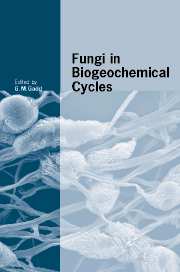Book contents
- Frontmatter
- Contents
- List of Contributors
- Preface
- 1 Geomicrobiology: relative roles of bacteria and fungi as geomicrobial agents
- 2 Integrated nutrient cycles in boreal forest ecosystems – the role of mycorrhizal fungi
- 3 Fungal roles in transport processes in soils
- 4 Water dynamics of mycorrhizas in arid soils
- 5 Integrating ectomycorrhizal fungi into quantitative frameworks of forest carbon and nitrogen cycling
- 6 Role of arbuscular mycorrhizal fungi in carbon and nutrient cycling in grassland
- 7 The role of wood decay fungi in the carbon and nitrogen dynamics of the forest floor
- 8 Relative roles of bacteria and fungi in polycyclic aromatic hydrocarbon biodegradation and bioremediation of contaminated soils
- 9 Biodegradation and biodeterioration of man-made polymeric materials
- 10 Fungal dissolution and transformation of minerals: significance for nutrient and metal mobility
- 11 Fungal activities in subaerial rock-inhabiting microbial communities
- 12 The oxalate–carbonate pathway in soil carbon storage: the role of fungi and oxalotrophic bacteria
- 13 Mineral tunnelling by fungi
- 14 Mineral dissolution by ectomycorrhizal fungi
- 15 Lichen biogeochemistry
- 16 Fungi in subterranean environments
- 17 The role of fungi in carbon and nitrogen cycles in freshwater ecosystems
- 18 Biogeochemical roles of fungi in marine and estuarine habitats
- Index
- References
1 - Geomicrobiology: relative roles of bacteria and fungi as geomicrobial agents
Published online by Cambridge University Press: 10 December 2009
- Frontmatter
- Contents
- List of Contributors
- Preface
- 1 Geomicrobiology: relative roles of bacteria and fungi as geomicrobial agents
- 2 Integrated nutrient cycles in boreal forest ecosystems – the role of mycorrhizal fungi
- 3 Fungal roles in transport processes in soils
- 4 Water dynamics of mycorrhizas in arid soils
- 5 Integrating ectomycorrhizal fungi into quantitative frameworks of forest carbon and nitrogen cycling
- 6 Role of arbuscular mycorrhizal fungi in carbon and nutrient cycling in grassland
- 7 The role of wood decay fungi in the carbon and nitrogen dynamics of the forest floor
- 8 Relative roles of bacteria and fungi in polycyclic aromatic hydrocarbon biodegradation and bioremediation of contaminated soils
- 9 Biodegradation and biodeterioration of man-made polymeric materials
- 10 Fungal dissolution and transformation of minerals: significance for nutrient and metal mobility
- 11 Fungal activities in subaerial rock-inhabiting microbial communities
- 12 The oxalate–carbonate pathway in soil carbon storage: the role of fungi and oxalotrophic bacteria
- 13 Mineral tunnelling by fungi
- 14 Mineral dissolution by ectomycorrhizal fungi
- 15 Lichen biogeochemistry
- 16 Fungi in subterranean environments
- 17 The role of fungi in carbon and nitrogen cycles in freshwater ecosystems
- 18 Biogeochemical roles of fungi in marine and estuarine habitats
- Index
- References
Summary
Introduction
The following definition of geomicrobiology will provide a proper context for the discussion in this essay. Geomicrobiology is a study of the role that microbes have played in the geologic past from the time of their first appearance on the planet Earth about 4 eons ago to the present, and the role they are playing today and are likely to play in the future in some of the processes that are of fundamental importance to geology. The discussion will be restricted to current geomicrobial activities because being able to observe them directly, we know most about them. Geomicrobial activities in the geologic past have been deduced from the detection in the geologic record of (1) microbial fossils that morphologically resemble present-day microorganisms of geologic significance and (2) relevant biomarkers. Past geomicrobial activities have also been inferred from present-day geomicrobial activities that occur under conditions similar to those presumed to have existed in the geologic past. Molecular phylogeny is providing information that supports inferences about ancient geomicrobial activity.
Geomicrobial agents
Phylogenetic distribution
Although geomicrobial agents that are presently recognized include members of the domains Bacteria (Eubacteria) and Archaea in the Prokaryota and members of Algae, Protozoa and Fungi in the Eukaryota, the following discussion will emphasize mainly geomicrobial activities of members of the Bacteria, Archaea and Fungi.
Geomicrobial activities
Types of geomicrobial activities
Geomicrobial activities play a role in (1) mineral formation, (2) mineral degradation, (3) the cycling of organic and inorganic matter, (4) chemical and isotopic fractionation and (5) fossil-fuel genesis and degradation.
- Type
- Chapter
- Information
- Fungi in Biogeochemical Cycles , pp. 1 - 27Publisher: Cambridge University PressPrint publication year: 2006
References
- 8
- Cited by



